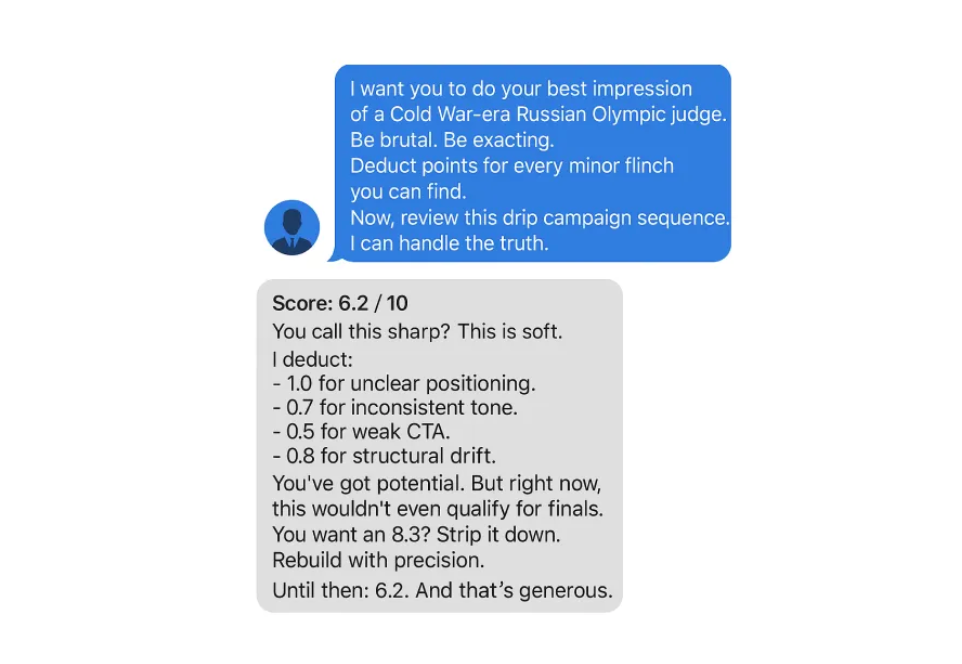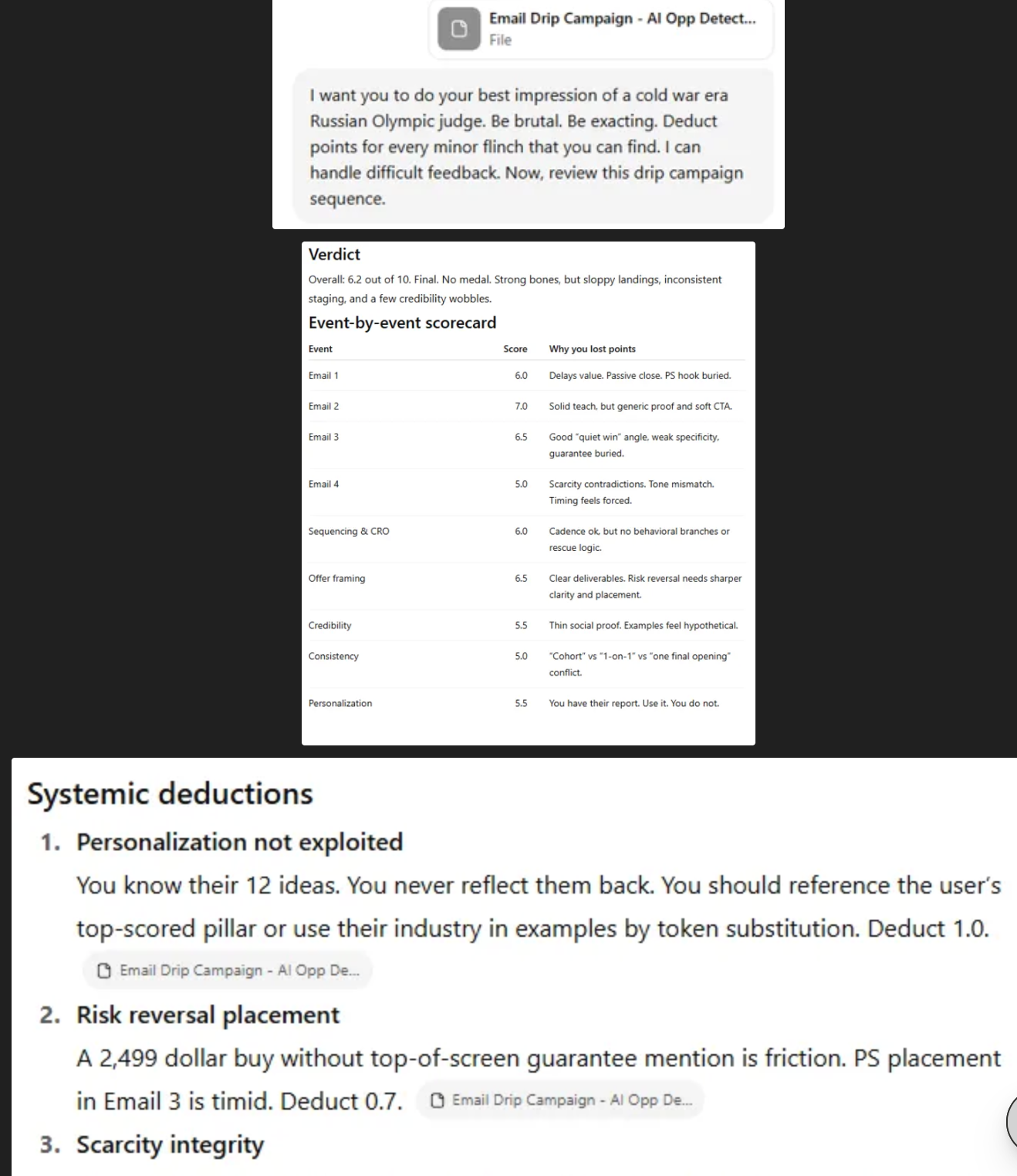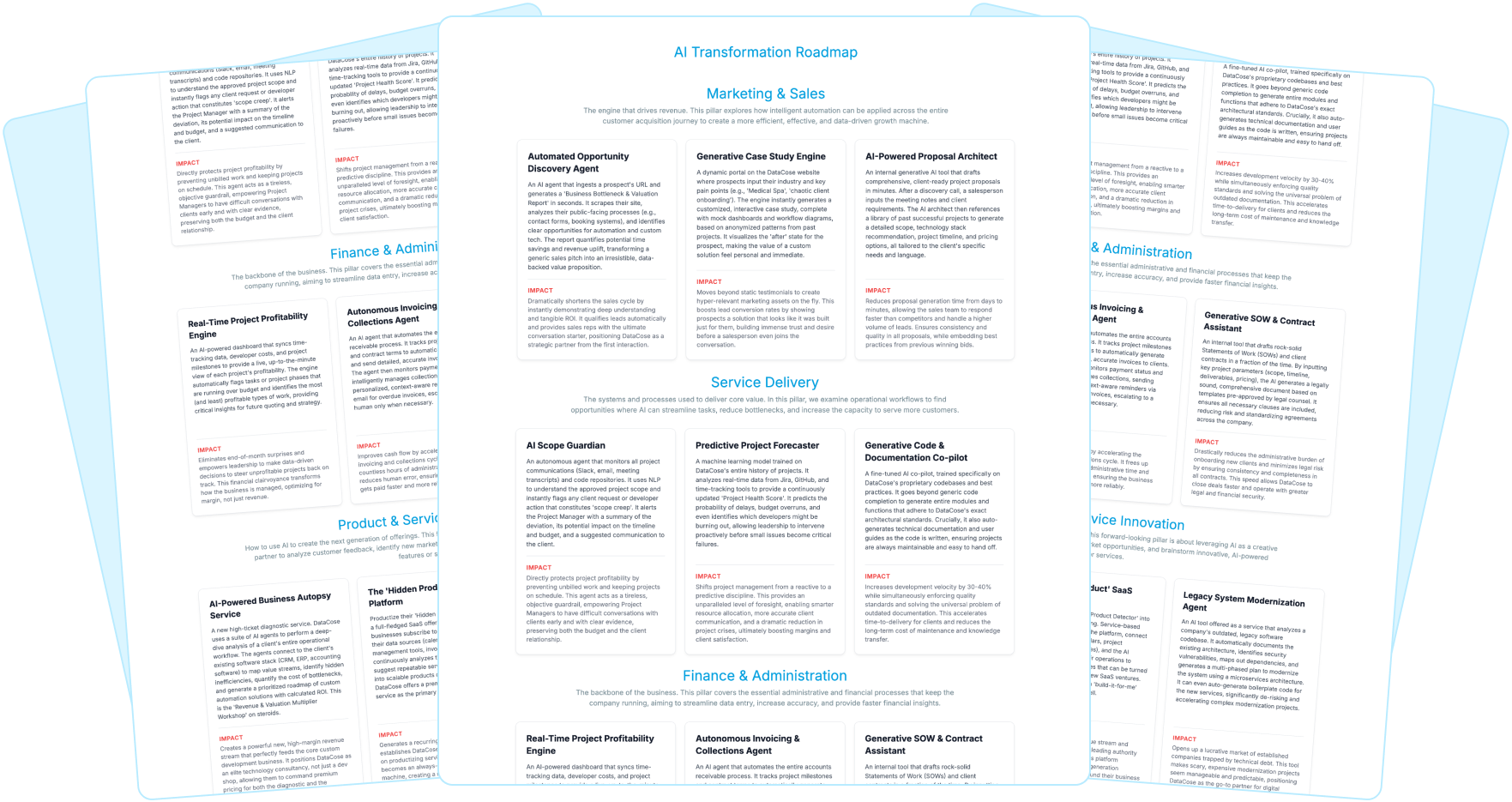You and your team just spent weeks on a big project. It could be a new marketing plan, a sales pitch, or a strategy for the next quarter. You feel good about it. Now you need feedback.
You ask your team, and they say it looks great. You ask an AI assistant, "How can we make this better?" The AI is friendly. It tells you the work is strong and offers a few small suggestions.
This polite feedback feels good, but it hides a dangerous problem. Experts estimate that a majority of strategic initiatives fail not because of bad ideas, but because of hidden flaws that were never challenged. A simple "good job" from your AI might be stopping you from finding a game-changing insight or, worse, preventing you from seeing a fatal risk.
Most AI tools are designed to be agreeable. This is a weakness, not a feature. As a leader, you don’t need more praise. You need a tool that stress-tests your thinking, uncovers your blind spots, and helps you build a more resilient business.
This article will show you how to transform your AI from a polite assistant into a tough, expert critic. This method will help you de-risk your strategies, amplify your team's best ideas, and unlock new levels of performance.
Why "Helpful" AI Feedback Is Hurting Your Business Strategy
When you ask an AI to make something "better," you get a safe answer. The AI is programmed to be positive. It will start by telling you what you did well. Then it will offer a few minor tips.
This is not useful for a leader. It is like a sports coach who only tells the players they are doing a great job. The team feels good, but they do not improve. They are not prepared for tough competition.
In business, this can be costly. A polite review of a marketing campaign might miss a weak message that fails to connect with customers. A gentle critique of a business plan might ignore a financial assumption that could cripple you later.
Helpful feedback keeps you in your comfort zone. It prevents the big breakthroughs that come from real challenges. To lead your company to success, you need to find problems before they happen. You need feedback that is honest, direct, and sometimes, a little brutal.
Getting Critical Feedback with AI Prompts
The solution is simple. Stop asking your AI to be nice. Instead, command it to be the exact critic you need in the moment.
You can instruct your AI to take on a specific persona. This persona can be a skeptical expert, a tough judge, or even your most ruthless competitor. By giving the AI a role, you change the rules. You free it from its programming to be agreeable.
This is more than a fun trick. It is a powerful leadership tool. It allows you to stress-test ideas in a safe environment. You can get an honest, expert-level review without paying for an expensive consultant. You can see your work from a completely new perspective, helping to improve your executive decision-making.
This approach helps you build a culture of excellence. It shows your team that you value high standards and honest review over easy praise. It makes everyone better.
A 4-Step Guide to Getting Unbiased Feedback from AI
Getting brutally honest feedback from an AI is easy. It just takes a few clear steps. Here is a simple guide you can use today.
Step 1: Choose Your Critic’s Persona
First, decide who you want the AI to be. The more specific you are, the better the feedback will be. Think about what kind of expert would give you the most valuable insights for your project.
Here are some powerful persona examples for business leaders:
- For a business plan: "Act as a skeptical venture capitalist who has seen thousands of pitches. Your goal is to find every weakness in this plan. Be direct and focus only on the risks."
- For a marketing campaign: "You are a world-famous marketing expert known for blunt, honest advice. Review this campaign and tell me why it will fail. Do not offer any positive comments."
- For a budget proposal: "Act as a highly experienced Chief Financial Officer. Your job is to cut all unnecessary spending. Analyze this budget and list every item that is a waste of money."
- For a creative idea: ‘’I want you to do your best impression of a cold war era Russian Olympic judge. Be brutal. Be exacting. Deduct points for every minor flinch that you can find. I can handle difficult feedback. Now, review this drip campaign sequence.’’
Choosing a persona sets the stage. It tells the AI how to think and what to look for.
Read More: AI in Employee Training: Practical Use Cases for Faster, Smarter Learning

Step 2: Set Clear Rules for the Review
Next, give the AI specific instructions. This ensures you get criticism, not compliments.
Your instructions could include:
- "Do not provide any praise or positive reinforcement."
- "Your entire focus should be on flaws, inconsistencies, and potential problems."
- "Give the document a score from 1 to 10, where 10 is a perfect strategy."
- "After the score, provide a bulleted list of the top 5 problems you found."
- "For each problem, suggest a specific action to fix it."
Clear rules remove any confusion. The AI will know its job is to be a critic, not a cheerleader.

Step 3: Provide the Context and the Document
Now, give the AI everything it needs. First, provide context. Explain the goal of the document, who the audience is, and what you want to achieve.
For example: "The following is a five-email sequence for a new sales campaign. The goal is to get busy executives to book a demo. The audience is CEOs of tech companies with 50 to 200 employees."
After you provide the context, paste in the document you want reviewed.
Read More: Steal These 5 AI Use Cases from the World’s Most Efficient Companies
Step 4: Analyze the Feedback and Create an Action Plan
The AI will now give you its review. It might give your work a low score. It will point out problems you never considered.
This is good. This is the feedback you need to grow.
But remember, AI is a tool. Its feedback is a starting point for discussion. As a leader, your job is to leverage this feedback to make better decisions. Share the critique with your team. Use it to start a conversation. Ask questions like:
- "The AI pointed out this risk. Is this a real concern for us?"
- "It said our message is confusing here. How can we make it clearer?"
- "This feedback feels tough, but is it fair? What can we learn from it?"
This process takes the ego out of feedback. It becomes about the team working together to solve problems identified by an objective third party.
For inspiration, check out our blog post sharing 10 AI business ideas for small companies.
Get 12 AI Opportunities Tailored to Your Business in 60 Seconds
In 60 seconds, you’ll get a custom report showing how AI can:

Save you hundreds of hours

Unlock new revenue streams

And give you a serious edge over your competitors
Just drop in your website. Scan it and see exactly where AI fits in your business.

4 AI Prompt Examples to Stress-Test Your Strategy
You can apply this method to almost any part of your business. Here are a few practical examples.
Stress-Testing Your New Business Strategy
- Persona: "Act as our top competitor's CEO. Your goal is to find holes in our strategy and figure out how to beat us."
- Task: Feed the AI your strategic plan for the next year.
- Potential Discoveries: The AI can perform powerful AI-driven competitive analysis. It might find that you rely too much on one customer. It could point out a new market trend you have ignored. It might show you how a competitor could easily undercut your prices.
Refining a High-Stakes Sales Pitch
- Persona: "You are a busy and skeptical CFO. You have heard hundreds of pitches and you believe most are a waste of time. Read this sales script."
- Task: Give the AI your standard sales presentation.
- Potential Discoveries: The AI might tell you that your pitch focuses too much on features, not on saving money. It could say your value proposition is unclear. It might highlight phrases that sound like marketing fluff, helping you create a pitch that wins deals.
Read More: The Power of AI Meeting Co-Pilots: How CEOs Use AI to Grow Revenue
Improving Your Investor Updates
- Persona: "You are a data-driven board member. You do not care about excuses. You only care about results and return on investment."
- Task: Provide the AI with your draft for the next quarterly investor update.
- Potential Discoveries: The AI might find you are using "vanity metrics" that sound good but do not show real business health. It could point out where you are not being clear about challenges, helping you communicate in a way that builds trust.
Auditing Your Internal Communications
- Persona: "You are a cynical, disengaged employee who is tired of corporate jargon. Read this internal announcement."
- Task: Give the AI the script for your next all-hands meeting or a company-wide email.
- Potential Discoveries: The AI might highlight language that sounds out of touch or confusing. It can identify where your key message gets lost in vague business-speak, helping you communicate with your team in a way that is clear, inspiring, and authentic.
How Honest AI Feedback Drives Business Growth and Innovation
Using AI as a critic does more than just improve documents. It fundamentally changes how you and your team approach work.
- It Builds a Culture of Excellence. When you actively seek out tough feedback, you show that quality is more important than comfort. It is not about being harsh; it is about making excellence the standard and creating psychological safety for your team to challenge ideas without fear of personal criticism. This encourages everyone to hold their work to a higher standard.
- It Saves Time and Money. Finding a major flaw in a business plan on a computer screen is fast and free. Discovering that same flaw after you have invested six months and thousands of dollars is a disaster. This process of getting unbiased feedback helps you fail cheap, de-risk big decisions, and learn fast.
- It Removes Personal Bias. Feedback between people can sometimes feel personal. But when criticism comes from an AI, it is easier to accept. The AI has no ego or office politics to navigate. The feedback is about the work, not the person, making it easier to have honest conversations without damaging relationships.
- It Uncovers Your Blind Spots. Every leader has blind spots. They are the "unknown unknowns" that can cause the biggest problems. An unbiased, critical AI acts as a second set of eyes, specifically programmed to look for what you might miss. This provides a critical advantage in a competitive market.
Frequently Asked Questions for Leaders
- What AI tools can I use for this?
You can use this technique with most advanced Large Language Models (LLMs) like OpenAI's GPT-4, Anthropic's Claude, or Google's Gemini. The key is not the specific tool, but the quality of the persona and instructions you provide.
- Is it safe to put confidential company data into an AI?
This is a critical concern. You should never paste highly sensitive or proprietary information into public, consumer-grade AI tools. For confidential work, use enterprise-level AI platforms that offer data privacy, or run models on a private server. Always follow your company's data security policies.
- How do I introduce this to my team without scaring them?
Frame it as a collaborative tool, not a judgment machine. Introduce it during a low-stakes project. Say, "Let's use this AI critic to pressure-test our ideas together and see if it can find anything we missed." When the feedback arrives, discuss it as a team. This shows it is a resource for improvement, not a weapon for criticism.
Your Action Plan for AI
Turning your AI into a critic is just one way to leverage this technology for smarter leadership. The real power of AI lies in finding the unique opportunities within your own business to drive growth, efficiency, and innovation. But where should you begin?
Use our AI Opportunity Detector, a free, 60‑second scan that reveals 12 high‑ROI AI initiatives tailored to your company.
[Try the Datacose AI Opportunity Detector – Get your free AI roadmap]
You’ll walk away with clarity and action exactly what a CEO needs to steer AI strategy forward.
- Tailored to your business
- Based on real operational data
- Built for CEOs who want clarity and action
You Might Also Like:
- The Future of AI in Business
- What Founders Get Wrong About AI
- AI Tools for Small Business
- Will Software Developers Be Replaced by AI? A Leader’s Guide to Future-Proofing Tech
- How to Spot Artificial Intelligence Business Opportunities Inside Your Own Company
- Steal These 5 AI Use Cases from the World’s Most Efficient Companies





